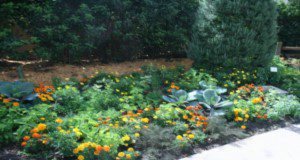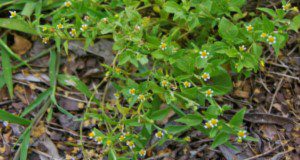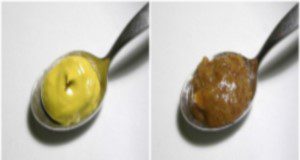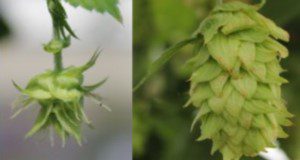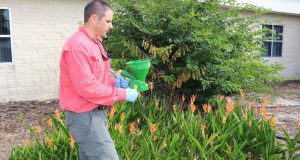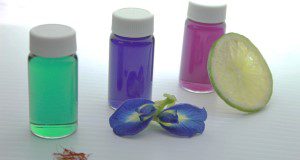Maintaining edible landscapes in a way that protects the environment is an important concern for protecting Florida’s water quality. The objective of this new 7-page publication is to introduce the framework of the Florida-Friendly Landscaping™ principles and apply the principles to guide decisions about Best Management Practices (BMPs) for care of edible landscapes. Written by Tiare Silvasy, Lynn Barber, Esen Momol, Tina McIntyre, Tom Wichman, Gail Hansen, Jen Marvin, Terra Freeman, Joseph Sewards, Wendy Wilber, and Jacqlyn Rivas.
https://edis.ifas.ufl.edu/ep594
Tag: MFREC
Biology and Management of Galinsoga (Galinsoga quadriradiata) in Ornamental Crop Production
Galinsoga (Galinsoga quadriradiata) is an erect (upright), herbaceous, short-lived warm-season annual weed in Florida landscapes, container nurseries, and other agricultural production systems. In nurseries and landscapes, galinsoga can be a troublesome weed, but it has been utilized by some cultures for food or medicinal purposes. This new 5-page article is written for green-industry professionals and others to aid in the identification and management of galinsoga in and around ornamental plants. Written by Thomas Smith, Chris Marble, Shawn Steed, and Nathan Boyd, and published by the UF/IFAS Environmental Horticulture Department.
https://edis.ifas.ufl.edu/ep593
Small-to-Medium-Scale Sensory Evaluation of Horticultural Crops: Sensory Attributes
Given the economic impact associated with the value and acceptability of horticultural crops, sensory evaluation is commonly employed in research, product development, and quality control, with very specific parameters outlined for its proper execution. The resulting data can be used to make sound decisions about crop quality and marketability, ultimately determining the overall value. This new 3-page publication of the UF/IFAS Environmental Horticulture Department is the first in a series designed to assist producers in the small-to-medium-scale sensory evaluation of their horticultural crops, outlining sensory attributes essential to sensory evaluation, including appearance, aroma, texture, and flavor. Written by Sean Michael Campbell and Charles A. Sims.
https://edis.ifas.ufl.edu/ep579
Harvest Techniques for Hops (Humulus lupulus)
Hops (Humulus lupulus) are perennial plants commonly harvested for their mature strobiles, also referred to as cones, which are primarily dried and used as a bittering agent and preservative in beer production. The two primary factors of harvest timing and harvest method can have large impacts on the quality and economics of the finished product. The decision of when and how to harvest is important and should rely upon growing-region-specific environmental conditions, physical observations of the cones, and the wants and needs of the individual producer. This new 4-page publication of the UF/IFAS Environmental Horticulture Department describes the primary methods used in hop harvesting, including field, indoor, and machine harvesting. Written by Sean Michael Campbell and Brian J. Pearson.
https://edis.ifas.ufl.edu/ep578
Florida Homeowner Herbicide Guide: Considerations, Applications, and Selection
While some people opt for professional lawn maintenance companies, some homeowners may wish to perform their own landscape pest control in order to save money, to have more control of what is applied, or simply because they enjoy it. This EDIS publication is for Florida gardeners, horticulturalists and homeowners who want to utilize herbicides to control weeds in their landscape. This new 9-page publication of the UF/IFAS Environmental Horticulture Department discusses common herbicides available at retail stores and how homeowners can use these them safely and effectively. Written by Chris Marble.
https://edis.ifas.ufl.edu/ep575
Butterfly Pea (Clitoria ternatea) Flower Extract (BPFE) and Its Use as a pH-Dependent Natural Colorant
Butterfly pea (Clitoria ternatea), a twining vine native to Southeast Asia, produces deep blue to purple flowers that bloom nearly year-round in ideal conditions. When extracted in a liquid, the addition of a mild acid such as lemon or lime juice turns the naturally deep blue to purple color into a much lighter pink or purple color, giving the extract its color-changing ability. This new 5-page publication of the UF/IFAS Environmental Horticulture Department outlines the use of butterfly pea flower extract (BPFE) as a pH-dependent natural colorant, including an explanation of the science behind the color change, detailed parameters for flower extraction, instructions for storage and processing of the extract as well as a discussion of some of the other benefits of using BPFE. Written by Sean Michael Campbell and Brian Pearson.
http://edis.ifas.ufl.edu/ep573
